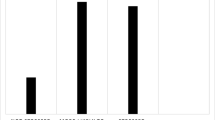Abstract
Purpose
Radiology is among the specialties with an increasing risk of litigation. Regardless of the outcome of legal proceedings, physicians who are sued usually perceive the claim as an assault on their integrity and may suffer psychological or physical effects known as “malpractice stress syndrome”.
Materials and methods
Two hundred and six radiologists and 108 radiotherapists responded to a questionnaire containing specific items concerning their perception of malpractice stress and their opinions about the causes of clinical errors, as well as an assessment of work satisfaction and general health.
Results
One third of physicians had been sued for malpractice. Age was significantly related to the occurrence of malpractice litigation. Radiological errors were purportedly related to occupational discomfort, and the latter variable was significantly associated with work dissatisfaction and a low level of psychological and physical well-being.
Conclusions
Radiologists are well acquainted with medical malpractice and its causes; however, they have limited familiarity with clinical risk management practices and often ignore procedures of informed consent. A targeted educational effort is required to overcome these shortcomings.
Riassunto
Obiettivo
Le denunce contro i radiologi per responsabilità civile e penale sono in continuo aumento. Indipendentemente dall’esito del processo, il medico coinvolto può andare incontro ad una serie di disturbi psicofisici che vanno sotto il nome di “stress da malpractice”. Abbiamo inteso indagare le opinioni dei radiologi sul fenomeno della malpractice medica e le esperienze di coloro che sono stati denunciati per malpractice.
Materiali e metodi
Un questionario relativo alle cause dell’errore e della malpractice ed alle sue conseguenze è stato sottoposto a 206 radiologi e 108 radioterapisti, nel corso di due congressi delle rispettive specialità.
Risultati
Mentre l’occorrenza di denunce per presunta malpractice si correla con l’età dello specialista, la frequenza degli errori sarebbe associata ad un insieme di fattori di disagio lavorativo, che a loro volta si correlano con una scarsa soddisfazione dal lavoro e un ridotto benessere psicofisico.
Conclusioni
I radiologi hanno una buona conoscenza del fenomeno della cosiddetta malpractice medica e della cause che contribuiscono ad enfatizzarlo, così come delle condizioni lavorative che causano stress da lavoro, insoddisfazione e aumento degli errori; mostrano però una insufficiente padronanza delle tecniche di clinical risk management e della dottrina del consenso informato. Per colmare tale tipo di carenza è necessario uno sforzo educativo particolare.
Similar content being viewed by others
References/Bibliografia
Fileni A, Magnavita N (2006) A 12-year follow-up study of malpractice claims against radiologist in Italy. Radiol Med 111:1009–1022
Charles SC, Pyskoty CE, Nelson A (1988) Physicians on trial-self-reported reactions to malpractice trials. West J Med 148:358–360
Elmore JG, Taplin SH, Barlow WE et al (2005) Does litigation influence medical practice? The influence of community radiologists’ medical malpractice perceptions and experience on screening mammography. Radiology 236:37–46
Farria DM, Schmidt ME, Monsees BS et al (2005) Professional and economic factors affecting access to mammography: a crisis today, or tomorrow? Results from a national survey. Cancer 104:491–498
Bassett LW, Monsees BS, Smith RA et al (2003) Survey of radiology residents: breast imaging training and attitudes. Radiology 227:862–869
Arnetz JE, Arnetz BB (2000) Implementation and evaluation of a practical intervention programme for dealing with violence towards health care workers. J Adv Nurs 31:668–680
Magnavita N (1998) Violenza sul lavoro: uno specifico femminile? Atti del 61° Congresso Nazionale SIMLII, Cianciano, 1998
Papalia F, Magnavita N (2003) Un rischio professionale misconosciuto: la violenza fisica sul luogo di lavoro. G Ital Med Lav Erg 25:3
Warr P, Cook J, Wall T (1979) Scales for the measurement of some work attitudes and aspects of psychological well-being. J Occup Psychol 52:129–148
Ulmer B, Harris M (2002) Australian GPs are satisfied with their job: even more so in rural areas. Family Practice 19:300–303
Goldberg D (1972) The detection of psychiatric illness by questionnaire. Oxford University Press
Martin CR, Newell RJ (2005) The factor structure of the 12-item General Health Questionnaire in individuals with facial disfigurement. J Psychosom Res 59:193–199
Armitage P, Betty G (1996) Statistica medica. Metodi statistici per la ricerca in medicina. Mc Graw Hill Italia, Milano
Studdert DM, Mello MM, Sage WM et al (2005) Defensive medicine among high-risk specialist physicians in a volatile malpractice environment. JAMA 293:2609–2617
Bartlett EE (1998) Physicians’ cognitive errors and their liability consequences. J Health Risk Manag. 18:62–69
Berlin L, Hendrix RW (1998) Perceptual errors and negligence. AJR Am J Roentgenol 170:863–867
Pescarini L, Inches I (2006) Systematic approach to human error in radiology Radiol Med 111:252–267
Commissione Tecnica sul Rischio Clinico (2004) Analisi dei processi di cura per attività: attività radiologica. Allegato 4A. In: Risk management in Sanità. Il problema degli errori. Ministero della Salute, Roma, pp 79–84 http://www.ministerosalute.it/programmazione/qualità/Documenti/rischio-clinico-280704.pdf
Reason J (2000) Human errors: models and management. West J Med 172:393–396
Goldberg RM, Kuhn G, Andrew LB, Thomas HA Jr (2002) Coping with medical mistakes and errors in judgment. Ann Emerg Med 39:287–292
American Psychiatric Association (2000) DSM-IV-TR. Diagnostic and Statistical Manual of Mental Disorders. Fourth Revision. Text revision. APA Pub. Arlington, VA pp 429–484
Riley GJ (2004) Understanding the stresses and strains of being a doctor. MJA 181:350–353
Author information
Authors and Affiliations
Corresponding author
Rights and permissions
About this article
Cite this article
Fileni, A., Magnavita, N., Mammi, F. et al. Malpractice stress syndrome in radiologists and radiotherapists: perceived causes and consequences. Radiol med 112, 1069–1084 (2007). https://doi.org/10.1007/s11547-007-0206-9
Received:
Accepted:
Published:
Issue Date:
DOI: https://doi.org/10.1007/s11547-007-0206-9




